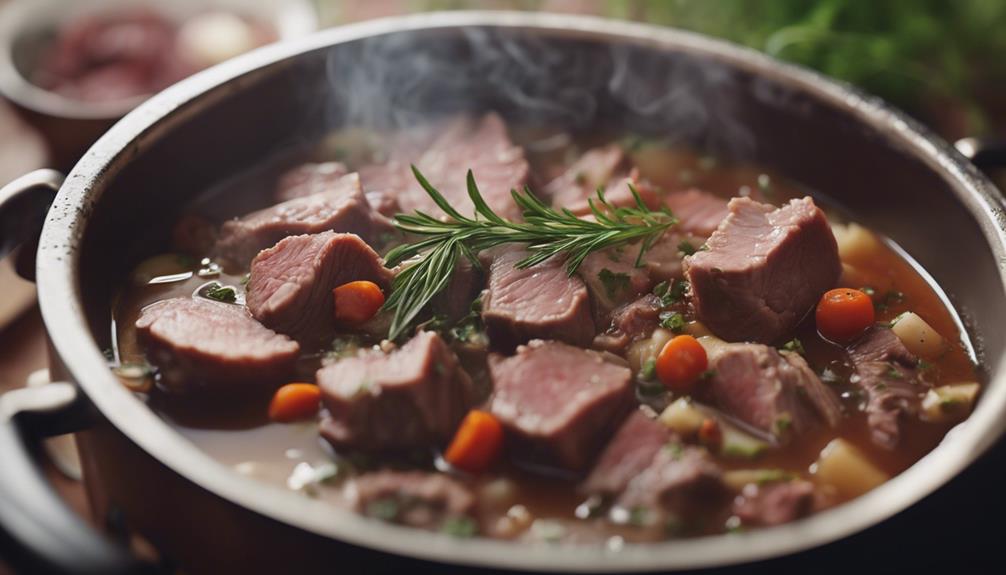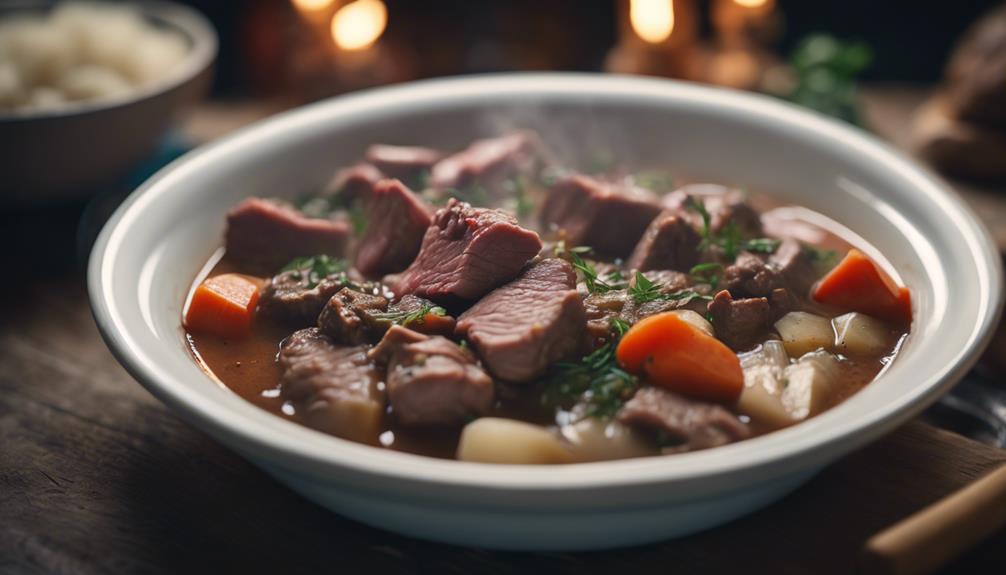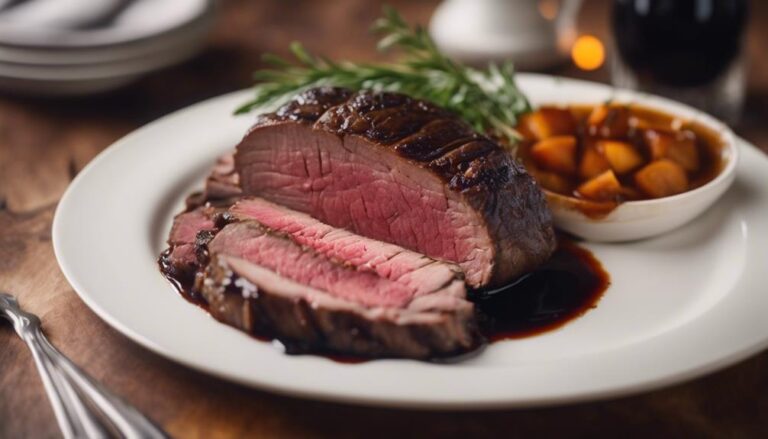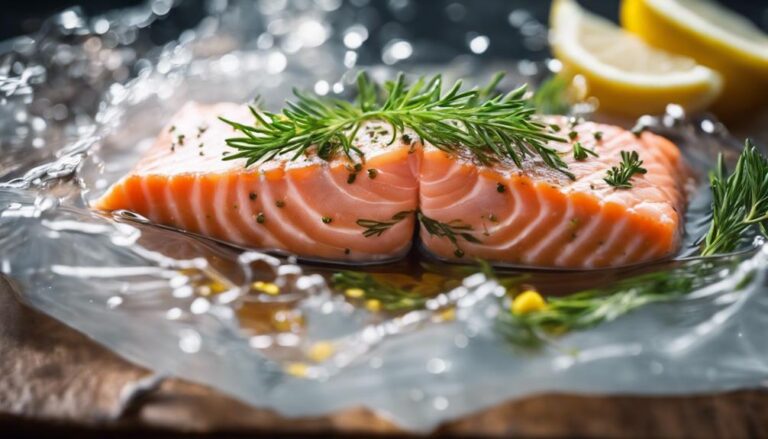Hearty Sous Vide Meat Stew: No Veggies Allowed
Step into a world of succulent sous vide meat stew, a paradise where veggies dare not tread. Sink your teeth into tender, flavor-packed meat, each bite a symphony of richness. This stew is a celebration of pure, unadulterated meaty goodness, no distractions allowed. Perfect for the uncompromising meat lover seeking an elevated culinary experience. Want to explore how this veggie-free masterpiece came to be and unravel its secrets further?
What You Will Learn Here
- Embrace the essence of meat without distractions from vegetables.
- Elevate the stew's richness with a focus solely on hearty meats.
- Create a decadent, meat-centric dish for ultimate satisfaction.
- Simplify the stew to highlight the full-bodied flavors of the meat.
- Cater to meat enthusiasts seeking a veggie-free, indulgent dining experience.
Stew's Evolution in Cuisine

Stew's journey in culinary history is a fascinating tapestry of flavors and techniques that have evolved over time. From its humble beginnings as a simple peasant dish to its contemporary renditions focusing on the essence of meat, stew has seen a remarkable transformation.
The interplay between traditional roots, modern interpretations, and innovative cooking methods like sous vide has propelled stew into a domain of endless possibilities.
Stew's Historical Roots
Having originated as a method to preserve and tenderize tough cuts of meat, beef stew has undergone a fascinating evolution in cuisine. Initially used for cooking the stew, this dish has transformed from a simple preservation method to a culinary delight.
Over time, stew recipes have evolved to include a myriad of ingredients like vegetables, herbs, and spices, enhancing both flavor and nutritional value. Different cultures have put their unique spin on stew, incorporating regional ingredients and cooking techniques passed down through generations.
During the Middle Ages, stew became a popular comfort food, prepared in communal settings over open fires. Today, modern variations of stew cater to changing tastes by focusing on the rich flavors of meat, sometimes omitting vegetables altogether.
Modern Stew Variations
In the world of modern culinary innovation, stew has undergone a remarkable metamorphosis, embracing diverse ingredients and cooking methods to redefine traditional flavors and textures. Chefs now experiment with unique elements like exotic spices, different meats such as chuck roast, and international flavors to create contemporary stew variations.
Innovative techniques like using a sous vide machine have revolutionized the stew-making process, allowing for precise temperature control and enhanced tenderness in the meat. Additionally, non-traditional bases such as coconut milk, miso, or beer are being incorporated to add depth and complexity to modern stews.
Fusion cuisines further push the boundaries by blending traditional stew recipes with modern twists, resulting in dishes that showcase a fusion of diverse cultural influences. The presentation of modern stews focuses on artistic plating, utilizing garnishes, edible flowers, and unconventional serving vessels to create visually appealing dishes.
Sous Vide Impact
Utilizing the sous vide technique has fundamentally transformed the way stew is approached in modern culinary practices, ushering in a new era of precision and flavor enhancement in meat-based dishes. The sous vide impact on stew is undeniable, as this method guarantees precise temperature control, resulting in consistently tender and juicy meat.
By focusing solely on the hearty meat and eliminating the need for vegetables, sous vide cooking allows the flavors and textures of the meat to shine through. This evolution in stew cuisine showcases how sous vide cooking can elevate traditional dishes to new heights of taste and quality.
Through extended cooking periods that optimize tenderness and flavor development, sous vide has become a game-changer in the world of stew preparation.
Key Stew Components

When crafting a sous vide meat stew without any vegetables, the focus shifts entirely onto the rich and hearty flavor of the meat itself. This approach allows for a more intense and concentrated taste experience, perfect for those who truly appreciate the essence of beef in their dish.
Here are key components to contemplate:
- Quality Beef: Opt for a high-quality cut of beef, such as chuck roast or brisket, to confirm a flavorful and tender outcome.
- Rich Broth: A robust broth made from beef stock or bone broth serves as the foundation of the stew, imparting deep umami notes.
- Aromatic Herbs and Spices: Enhance the meaty flavors with a blend of herbs like rosemary and thyme, along with spices such as black pepper and paprika.
- Thickening Agent: Contemplate using a thickening agent like flour or cornstarch to achieve the desired consistency and add a velvety texture to the stew.
Guinness Beef Stew Variations
When considering Guinness beef stew variations, you'll find that the unique flavor twist of Recipe #1 combines beef with stout in a Sous Vide Stout Marinade, offering a rich and distinct taste.
This variation adds depth to the traditional stew by infusing the meat with the bold flavors of Guinness stout, creating a savory and indulgent dish.
The combination of beef and stout in this recipe elevates the overall flavor profile, making it a standout choice for those seeking a new take on a classic stew.
Unique Flavor Twist: Recipe #1
For a bold departure from the traditional Guinness Beef Stew, this recipe offers a meat-centric twist that celebrates the rich flavors of beef and Guinness without the distraction of vegetables. By focusing solely on the meat, this variation highlights the robust taste of the beef and the deep, malty notes of the Guinness, creating a hearty and flavorful stew that will satisfy any meat lover.
Here are some key points to enjoy this unique twist:
- Enhanced beef flavor through sous vide cooking.
- Intensified richness with a hearty beef stock base.
- Concentrated Guinness taste without vegetable interference.
- A meat-centric experience perfect for those seeking a unique take on the classic stew.
Beef and Stout Combination
To explore the depth of flavor in Guinness beef stew variations, consider the dynamic interplay between beef and stout that heightens this classic dish to new heights. When it comes to sous vide beef dishes infused with stout like Guinness, the results are mouthwatering and unforgettable. Here's why this combination stands out:
- Tender Beef: Sous vide cooking guarantees the beef in the stew is perfectly tender and juicy.
- Rich Flavor: The stout beer imparts a rich, malty flavor that complements the beef beautifully.
- Complex Aromas: The slow cooking process allows the beef to absorb the deep, complex aromas of the stout.
- Balanced Taste: The marriage of beef and stout creates a harmonious balance of savory and robust flavors that will leave you wanting more.
Sous Vide Stout Marinade
Craft a bold Stout marinade for your sous vide beef, infusing it with the rich, malty flavors of Guinness for an unparalleled culinary experience. When marinating meat in stout for sous vide cooking, you're in for a treat. Here's how to make the most of it:
- Enhance meat tenderness and flavor with a stout marinade
- Customize your stout marinade with herbs, spices, and aromatics
- Infuse your beef with depth and complexity by soaking it in stout
- Elevate the overall dish by incorporating the unique taste of Guinness
With these tips, your sous vide stout marinade will take your beef stew to new heights, pleasing even the most discerning palates.
Searing for Meat Flavor
When searing meat, you're not just adding color; you're revealing a symphony of flavors. The Maillard reaction is your ally here, turning the surface of the meat into a canvas of taste.
Searing Enhances Meat Flavor
Enhancing the flavor of your meat stew begins with the essential step of searing to develop a rich crust through the Maillard reaction. Searing your meat at high heat not only enhances its taste but also adds complexity and depth to the overall flavor profile.
The Maillard reaction during searing caramelizes the natural sugars in the meat, resulting in a savory and aromatic outcome that will delight your taste buds. Additionally, the crust formed on the meat provides a delightful textural contrast to the tender sous vide meat in your stew.
Maillard Reaction Importance
The sizzling sound of meat hitting a hot pan signals the start of a transformative culinary process, where proteins and sugars undergo a flavorful metamorphosis through the Maillard reaction. Searing, an essential step in this process, not only enhances the taste and texture of meat but also contributes to the overall complexity of the stew.
The Maillard reaction, triggered by high heat, results in the browning of the meat, creating a rich crust that adds depth to the dish. By caramelizing the meat's surface, searing at elevated temperatures develops a flavorful and visually appealing exterior. This reaction is essential for achieving a contrast in textures, with the crispy seared exterior complementing the tender sous vide-cooked interior, elevating the sensory experience of the stew.
Flavor Development Through Searing
Searing meat at high temperatures not only caramelizes the surface but also enhances the savory essence of the dish, amplifying its overall flavor profile.
When you sear meat before incorporating it into your sous vide stew, you're not just creating a visually appealing crust; you're revealing a depth of flavor that comes from the Maillard reaction. This chemical process enriches the umami taste, giving your stew a rich and robust flavor that complements the tender sous vide meat.
Additionally, searing helps seal in juices, ensuring your stew remains moist and succulent. The contrast in texture between the caramelized exterior and the tender interior further elevates the dish, adding complexity and a satisfying mouthfeel to each bite.
Final Thoughts
In your culinary journey, exploring a sous vide meat stew without veggies reveals a world where the essence of meat reigns supreme. This hearty dish, cooked sous vide, celebrates the richness and tenderness of the meat, showcasing the technique's transformative power on even the toughest cuts.
By omitting vegetables, the focus remains solely on the meat, allowing its natural flavors and textures to take center stage. The consistent results and best tenderness achieved through sous vide cooking guarantee each bite is a succulent delight.
This stew, devoid of veggies, caters to meat enthusiasts seeking a hearty and comforting meal that indulges their carnivorous cravings. The absence of distractions from vegetables elevates the dish to a new level of meaty satisfaction, perfect for those who appreciate the full-bodied essence of a well-prepared meat stew.
Embrace the simplicity and decadence of a veggie-free sous vide meat stew for a truly gratifying dining experience.
Frequently Asked Questions
What Temperature Should Stew Meat Be Sous Vide?
When cooking stew meat sous vide, set the temperature precisely to 140°F for that perfect tenderness and juiciness. Best seasoning and following recommended sous vide times will guarantee a delicious dish. Enjoy your flavorful and hearty meal!
Can You Cook Multiple Things in Sous Vide?
Yes, you can cook multiple things in sous vide! Using separate bags for each ingredient guarantees precise cooking. It's perfect for desserts and cocktails too. Enjoy the convenience and consistency of preparing a variety of dishes simultaneously.
Do You Cook Vegetables Before Putting in Stew?
When making stew, consider your vegetable preferences. Cooking veggies before stewing can enhance their flavors. For veggie-free recipes, focus on seasoning and textures. Your choice impacts the final dish's taste and appearance.
Is Stew Meat Only Good for Stew?
Stew meat goes beyond stew; it's versatile. Try sous vide for tender results. Explore chili, braised dishes, and stir-fries. Experiment with flavor combos. Let your creativity shine with meaty delights beyond traditional stews.
Conclusion
Indulge in the rich flavors of a hearty sous vide meat stew, where the focus is on the succulent meat and savory broth without the distraction of vegetables. By utilizing the sous vide method, the meat is tender and cooked to perfection, allowing for a truly melt-in-your-mouth experience.
Experiment with different variations of Guinness beef stew to find your perfect combination of flavors. Embrace the simplicity and depth of flavor that comes from this veggie-free stew.
Bon appétit!











